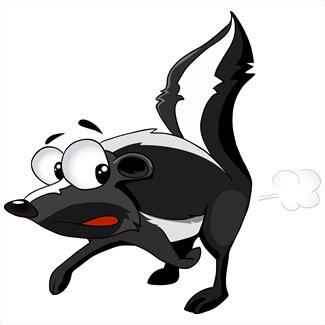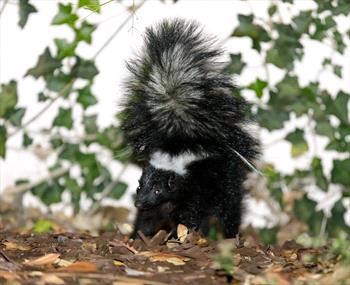Skunk illustration

Illustration courtesy of Depositphotos
Skunk Funk
If your little punk
Has been skunked
Have no fear,
Read here my dear
A recipe you will need
His funk to cede
By Valerie Brons, BVetM
Getting sprayed by a skunk happens to curious dogs who stick their noses into places that annoy skunks. It happens to cats, too, just not nearly as often. Unless your pet has been skunked, you may not realize that the odor stuck to your pet is not the same minor one that you smell driving down a road where a skunk has released its scent. The up close and personal smell won’t just make you wrinkle your nose and gag a bit; it’s a bit like the acrid smell of burning rubber or chemical fire that grasps your lungs and hurts your eyes. If people have this reaction from being next to their pet, imagine what pets, with their highly sensitive noses, feel.
Unfortunately, it is up to you to remove the odor. While you can take them to veterinarian, getting sprayed often happens outside clinic hours. Emergency rooms see some of these cases, although that is a costlier approach than doing it yourself. You can bathe them yourself with the formula created by a scientist in a laboratory.
1 quart 3% hydrogen peroxide
1/4 cup baking soda
1 teaspoon of liquid dish soap or hand soap
Hand soap is milder and won't strip out the oily residue as well as dish soap, so dish soap is preferable, but use what you have available.
It is unlikely that one shampoo with this recipe will be enough to eliminate that odor. Depending on the length of the pet’s coat, the volume of spray, and how long you are able to rub shampoo into the coat, you may need do it more than once, or even a few times.
Mixing
Typically, 3% hydrogen peroxide is sold in pint bottles, so two are needed for this recipe. Anything stronger than 3% is not recommended. If your bottle is expired, get fresh ones instead.
The best place to mix the formula is in a clean plastic bucket with plastic utensils to stir. Metal is not a good choice because it encourages the peroxide to decompose.
If needed to cover your whole dog, up to a quart of lukewarm water (not hot or cold water) can be added to the solution.
Apply the solution immediately, and do not store it in a bottle or spray bottle to avoid having the bottle explode. Bottles of hydrogen peroxide do not burst in the store because underneath the cap, on the cap liner, the manufacturer has left teeny holes through which the oxygen gas is released.
How Does it Work?
The nasty part of the skunk odor (is there any part that isn’t horrific?) is created by organic compounds called thiols, which are responsible for making other hideous odors such as decomposing flesh. The oxygen created by combining hydrogen peroxide and baking soda neutralizes the thiols.
Bathing
Skunks tend to aim for a dog’s face. Both the skunk spray and the solution you’ve made will sting (and possibly harm) a dog’s eyes, so keep the solution away from the eyes.
As soon as you can, wash your dog in this solution and really work it into the fur, particularly on long coated breeds. Leave the solution on the dog for about 5 minutes. Some areas that reek more than others may need more baths. Wash the dog as many times as it takes for the dog to smell like a wet dog rather than a dog sprayed by a skunk. It is possible that for a few months afterward the dog will smell slightly of skunk when wet.
Rinse the dog with lukewarm water.
Rinse any leftover solution down the drain with added water.
Safety Warnings (There are Several)
DO NOT SMOKE while shampooing as this mixture is flammable.
Toss out what you haven’t used; it can’t be bottled. The chemical reaction of pressure from hydrogen peroxide and baking soda will make it burst, and the explosion can cause injuries. The chemist who discovered it should have become filthy rich from it, but it can’t be bottled for long enough to package and sell it. It won’t even last an evening, so toss out what you haven’t used. If you intend to bathe your pet again tomorrow, make another batch then; it’s better to bathe them a few times the day it happens. Remember that a similar eruption in paper mache volcanoes is caused by combining dishwashing soap. baking soda and vinegar.
Hydrogen peroxide will lighten black hair to a bronze color, and that will not return to the usual darker shade on its own; note that hydrogen peroxide is an ingredient in permanent hair dye and some blonde hair dye. The fur will have to grow out. If you plan to show your black dog in conformation, consider some other option instead (see below).
Not unexpectedly, the solution will bleach out towels and fabric, so while you bathe the dog, wear old clothes and towels you don’t mind getting bleached.
Keep the solution out of your pet’s eyes. It can be irritating enough to cause shallow corneal ulcers. That may be difficult to prevent if the dog is sprayed directly in the face.
Skunk defensive position

This skunk is in a defensive posture. Skunks can aim their spray accurately about 10 to 20 feet. Photo courtesy of Depositphotos
Other Choices
That old silliness about using tomato juice or sauce to get rid of the odor is likely based on the acidity of tomatoes. It simply does not work.
Most veterinarians keep Thornell’s Skunk-Off at the clinic. Many over-the-counter products like this can be found at pet supply stores. It can also be used in the carpet, car seats, furniture, and so on. It does not contain hydrogen peroxide, so it can be used on black dogs. It is available in shampoos for pets and spray bottles for carpeting, bedding, clothing, upholstery, and so on. It can cause minor irritation.
A water and vinegar douche can work. First wash the dog in liquid soap and rinse it out well. Then apply the douche (a spray bottle works well) and leave it there; don’t rinse it off. Usually, unmedicated varieties do not expire.
For your house or car, keep the windows open, run air conditioning if you have it, and use whatever household product you have to eliminate odors indoors. The product may not help much, or at all, but it can’t hurt.
A Health Risk from the Skunk Spray
Dogs who get a full shot of skunk spray in the face can develop a form of damage to their red blood cells that causes anemia. This result can make the dog weak and turn their mucous membranes (gums, inside cheeks) a chocolate color. If that happens, veterinary intervention is needed. The dog may need blood transfusions and supportive measures. Severely skunked dogs should be monitored closely for 12 hours for such signs as lethargy, weakness, lack of appetite. Extremely severe cases of this resulting anemia can be fatal.
Most dogs that get sprayed by a skunk do not get bitten because they retreat after being sprayed. But if a dog is bitten by the skunk, the owner should seek veterinary attention due to rabies risk and for possible wound care.
Some dogs are more likely to encounter skunks, depending on their geographic area and temperaments, and you may need to do this more than once. If that is the case, consider keeping unexpired supplies on hand.